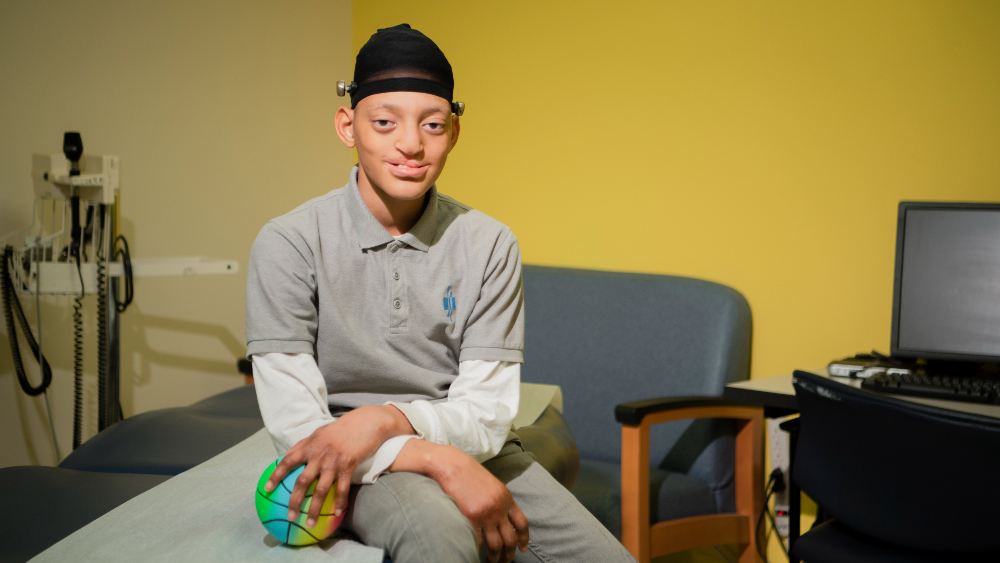Condition
Pediatric Pfeiffer Syndrome
What You Need to Know
Pfeiffer syndrome is a birth defect that causes problems with bones in a baby’s skull, face, fingers, and toes. This syndrome mainly causes the sutures (joints) between skull bones to grow together too early, which prevents the head and face from growing normally and affects their shape.
Key Symptoms
Babies with Pfeiffer syndrome may show symptoms including:
- Misshapen head: wide, high forehead and short head from front to back
- Unusually broad thumbs and big toes that are offset from the other fingers and toes
- Wide-set, bulging eyes
- Unusually small upper jaw
- Small, beak-shaped nose
- Crowded, crooked teeth
- Hearing loss
- Partially fused or webbed, or unusually short fingers and toes
- Sleep apnea because of nasal airway blockage
Diagnosis
Our pediatric team uses the following tools to help diagnose Pfeiffer syndrome:
- X-rays
- Diagnostic imaging, especially CT scans
- Genetic tests
Treatment
Treatment of Pfeiffer syndrome will vary from child to child but may include:
- Surgery through out their life to aid in reshaping the skull and correcting sleep apnea
- Speech therapy

Schedule an Appointment
Our pediatric specialists provide personalized care for your child’s physical, mental and emotional health needs. Meet the providers who treat Pfeiffer syndrome and schedule an appointment today.
Frequently Asked Questions
Explore frequently asked questions about Pfeiffer syndrome.
What Is Pfeiffer Syndrome?
Pfeiffer syndrome is a birth defect that causes problems with bones in a baby’s skull, face, fingers, and toes. This syndrome mainly causes the sutures (joints) between skull bones to grow together too early, which prevents the head and face from growing normally and affects their shape.
What Causes Pfeiffer Syndrome?
Genes that mutate during fetal development or are passed from parent to child can cause Pfeiffer syndrome. These genes cause the coronal (ear-to-ear), lambdoid (across the back of the head), and possibly sagittal (top of head, front to back) sutures to fuse together prematurely (craniosynostosis).
What Are the Types of Pfeiffer Syndrome?
There are three types of Pfeiffer syndrome:
- Type I: Mildest and most common
- Type II: Most severe with neurological problems and a cloverleaf deformity caused by more skull bone fusion
- Type III: Similar to type II without the cloverleaf deformity
Symptoms of Pfeiffer Syndrome
Babies with Pfeiffer syndrome may show symptoms including:
- Misshapen head: wide, high forehead and short head from front to back
- Unusually broad thumbs and big toes that are offset from the other fingers and toes
- Wide-set, bulging eyes
- Unusually small upper jaw
- Small, beak-shaped nose
- Crowded, crooked teeth
- Hearing loss
- Partially fused or webbed, or unusually short fingers and toes
- Sleep apnea because of nasal airway blockage
How Is Pfeiffer Syndrome Diagnosed?
Your pediatrician can usually detect Pfeiffer syndrome very early because of symptoms in the skull, thumbs, and big toes. Because skull deformities appear in several similar syndromes, your pediatrician will use other testing methods to make an accurate diagnosis.
At Children’s National, our pediatric team uses the following tools to help diagnose Pfeiffer syndrome:
- X-rays to check for fused (missing) sutures on the top or sides of the head, or ridges along these sutures
- Diagnostic imaging, especially CT scans, also to check for fused sutures or ridges along sutures
- Genetic tests to rule out other syndromes for an accurate diagnosis and treatment
Treatments for Pfeiffer Syndrome
Treatment goals focus on reshaping the skull and correcting obstructive sleep apnea. At Children’s National, our treatment options include:
- Surgery on the skull before 18 months of age
- Minimally invasive surgery for infants younger than 3 months to open skull sutures for normal skull and brain growth
- Traditional surgery for infants 6 months or older to correct the skull’s shape
- Surgery in later childhood to correct facial and jaw deformities, including obstructive sleep apnea
- Surgery to correct problems with the fingers or toes
- Speech therapy to help with speech and language development
Departments that Treat Pfeiffer Syndrome

Rare Disease Institute - Genetics and Metabolism
Children's National Rare Disease Institute (CNRDI) is a first-of-its-kind center focused exclusively on advancing the care and treatment of children and adults with rare genetic diseases.

Help Kids and Make a Difference
Invest in future cures for some of life's most devastating diseases.








